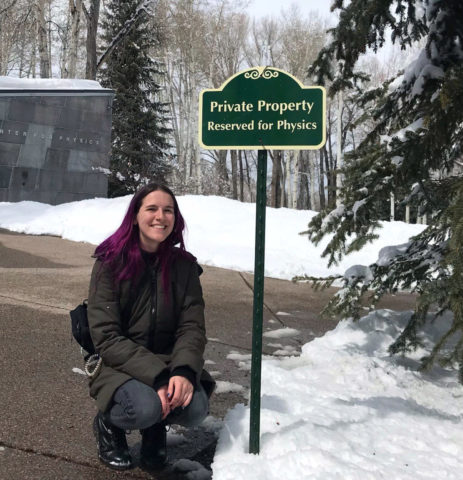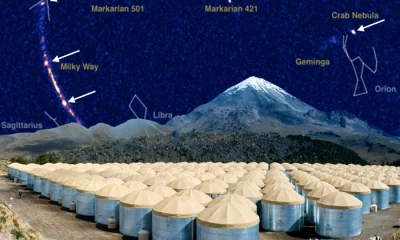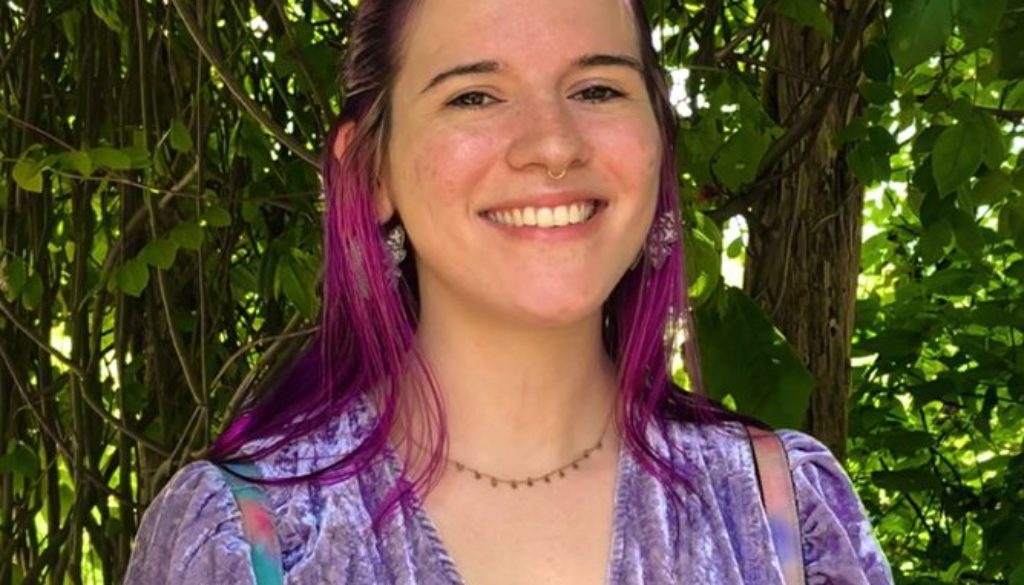Texas A&M Physics and Astronomy’s Addy Evans Selected for Department of Energy Graduate Student Research Award
Addy J. Evans ’21, a Ph.D. candidate in the Department of Physics and Astronomy at Texas A&M University, has been selected to receive a United States Department of Energy Office of Science Graduate Student Research (SCGSR) Program Award in support of research addressing scientific challenges central to the agency’s mission and workforce development.
Evans, who is completing her third year of study as a member of Texas A&M astronomer amd 2021 Presidential Impact Fellow Dr. Louis Strigari’s research group working at the interface of particle physics, astrophysics and cosmology within the George P. and Cynthia Woods Mitchell Institute for Fundamental Physics and Astronomy, is one of 80 awardees representing 27 states and 53 different U.S. universities that grant doctoral degrees in physical sciences for the program’s 2021 Solicitation 2 cycle. In addition, she is the third Texas A&M student to earn selection in the program’s eight-year history, joining Texas A&M chemistry graduate students Gregory S. Day ’19 (2019) and Hannah F. Drake ’18 (2020) in receiving the prestigious fellowship.

The goal of the SCGSR Program is to prepare graduate students for science, technology, engineering or mathematics (STEM) careers critically important to the DOE Office of Science’s mission by providing them with graduate-thesis-enhancing research opportunities at DOE national laboratories, where they will spend anywhere from 3-to-12 months conducting research in collaboration with a DOE laboratory scientist. The award includes travel support to and from the laboratory as well as a monthly stipend of up to $3,000 to help cover general living expenses while at the host DOE laboratory during the award period. Awardees are selected from a diverse pool of university-based graduate applicants based on merit peer review by outside scientific experts.
Evans is one of three current SCGSR awardees who will be conducting collaborative research at Los Alamos National Laboratory. She will be in residence there from June through September, working with J. Patrick Harding, a staff scientist in Los Alamos’ Physics Division and focus lead for the P-3 Gamma Ray Astrophysics team. Harding is doing research using the High Altitude Water Cherenkov (HAWC) Observatory, a wide field-of-view detector located in central Mexico that uses an array of water Cherenkov detectors to observe ultra-high energy photons from some of the most extreme astrophysical objects known, such as supernova remnants and blazars. Due to its unique capabilities, including sensitivity to gamma rays of 100 gigaelectronvolts (GeV) to a few hundred teraelectronvolts (TeV) — with one TeV being equivalent to the energy of motion of a flying mosquito — HAWC is opening up a new window on the ultra-high energy universe, one that Evans is excited to experience firsthand.
“I’m very grateful to receive this fellowship and to get the opportunity to work with my colleagues at Los Alamos National Laboratory on the High Altitude Water Cherenkov experiment.” Evans said. “One of the most exciting parts about working within the HAWC collaboration is that we’re studying some of the most energetic photons ever detected and learning about where in the Universe they originate from. To put into perspective just how energetic these photons are, they’re actually 10 to 100 times more energetic than the highest energy particles produced on Earth!”
Since 2014, the SCGSR program has provided more than 870 U.S. graduate awardees from 155 universities with supplemental funds to conduct part of their thesis research at a host DOE laboratory in collaboration with DOE laboratory scientists. More than 40% of the 2021 cohort are women, and roughly 14% of the students attend minority serving institutions (MSIs).
The SCGSR research projects are expected to advance each awardee’s overall doctoral thesis while providing access to the expertise, resources and capabilities available at the DOE laboratory facilities. In addition to strong alignment with one of the DOE Office of Science’s priority mission areas, each research project must demonstrate a high need for workforce development, given that the SCGSR Program plays an important role in sustaining a pipeline for highly skilled scientific and technological workforce development.

“For decades, DOE has cultivated the expertise to meet the nation’s greatest scientific challenges,” said Under Secretary of Science and Innovation Dr. Geraldine Richmond. “Now more than ever, we need to invest in a diverse, talented pipeline of scientists, engineers and entrepreneurs who will be the future science and innovation leaders of this country. I’m thrilled these outstanding students will help us tackle critical research at our labs, and I know their futures are bright.”
For her SCGSR research project, “TeV emission of globular clusters and its connection to dark matter,” Evans will be working with Harding and HAWC observatory colleagues to characterize the very high-energy emission of globular clusters — dense stellar systems within which gamma-ray emission has just recently been detected. Evans will be studying these systems to develop a better understanding of the astrophysical properties of dark matter and neutrinos, among other mysteries of fundamental physics.
“Only a small fraction of these compact stellar systems emit light at gamma-ray energies, and the physical processes that create these energetic photons are not entirely understood,” Evans said. “Moreover, learning about the gamma-ray emission of these systems is imperative to the search for dark matter, which has been theorized to also generate gamma-rays. I am very excited to work on this project, as it will give me the opportunity to explore both the extreme, high-energy environments within globular clusters as well as our prospects for detecting gamma-rays originating from dark matter.”
Evans earned her bachelor’s degree in physics with a minor in mathematics in May 2019 from Oklahoma State University prior to beginning her Ph.D. in astronomy at Texas A&M in fall 2019 with Strigari as her thesis advisor. She received her master’s of science in astronomy in October 2021 and is on track to earn her doctorate in astronomy in 2024.

Since 2019, Evans has served simultaneously as a teaching assistant, laboratory instructor and graduate research associate in Texas A&M Physics and Astronomy while also pursuing her primary research interests in high-energy astrophysics, galactic astronomy and the search for dark matter. Her first, first-author peer-reviewed paper recently has been published, and she has presented her research in a variety of venues, including the annual Texas A&M Astrosymposium (2019-2021), Astronomy on Tap-B/CS (2020 and 2021), the 2020 American Physical Society Texas Section, and a 2022 Conference at the Aspen Center for Physics. Evans also has served as a panelist at the 2020 Conference for Undergraduate Women in Physics, a project leader for the Warrior School Project: STEM Week (2020 and 2021) and an emcee for Astronomy on Tap-B/CS (fall 2021). In addition, she is one of the coordinators for the Mentoring and Advising Graduates in an Inclusive Community (MAGIC) program within Texas A&M Physics and Astronomy.
“Addy’s DOE SGSR fellowship is extremely well deserved and serves as recognition of her scientific accomplishments since she has been in our graduate program,” Strigari said. “In her three years here, Addy has already made important contributions to the fields of gamma-ray astrophysics and dark matter detection. Her interdisciplinary research in the field of astroparticle physics and cosmology embodies the scientific mission of the Mitchell Institute.”
Los Alamos National Laboratory is a multidisciplinary research institution engaged in strategic science on behalf of national security. It is managed by Triad, a public service oriented, national security science organization equally owned by its three founding members: Battelle Memorial Institute, the Texas A&M University System and the Regents of the University of California (UC) for the Department of Energy’s National Nuclear Security Administration.
To learn more about the Strigari and his research group, go to https://physics.tamu.edu/directory/strigari/.
# # # # # # # # # #
About the U.S. Department of Energy Office of Science: The Office of Science is the single largest supporter of basic research in the physical sciences in the United States and is working to address some of the most pressing challenges of our time.
About Research at Texas A&M University: As one of the world’s leading research institutions, Texas A&M is at the forefront in making significant contributions to scholarship and discovery, including that of science and technology. Research conducted at Texas A&M generated annual expenditures of more than $1.148 billion in fiscal year 2021. Texas A&M ranked 14th in the most recent National Science Foundation’s Higher Education Research and Development Survey based on expenditures of more than $1.131 billion in fiscal year 2020. Texas A&M’s research creates new knowledge that provides basic, fundamental and applied contributions resulting, in many cases, in economic benefits to the state, nation and world. To learn more, visit Research@Texas A&M.
-aTm-
Contact: Shana K. Hutchins, (979) 862-1237 or shutchins@science.tamu.edu; Addy J. Evans, (979) 845-7778 or addyjevans@tamu.edu; or Dr. Louis Strigari, (979) 845-7778 or strigari@tamu.edu
The post Texas A&M Physics and Astronomy’s Addy Evans Selected for Department of Energy Graduate Student Research Award appeared first on Texas A&M College of Science.
